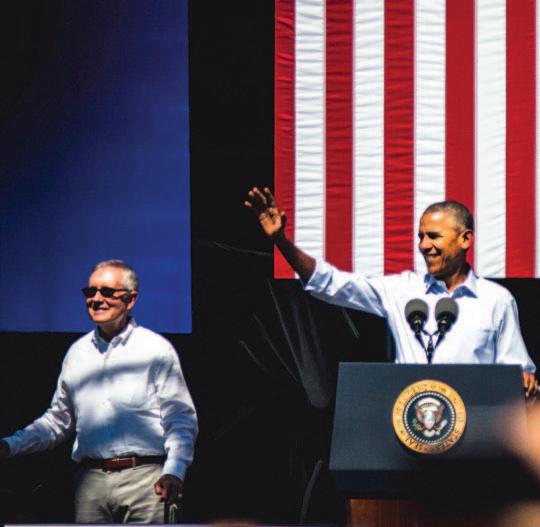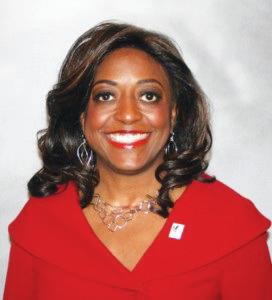
10 minute read
News
from Sept. 8, 2016
Obama’s future
U.S. Sen. Harry Reid said last week he does not believe Hillary Clinton, if elected, will choose Barack Obama as her secretary of state.
Advertisement
“You can’t go from being president to taking orders from some other president—no,” the retiring Nevada Democrat said. “That wouldn’t work.”
Obama surprised many after the 2008 election—including Clinton herself—when he asked his opponent in that year’s Democratic caucuses and primaries to become secretary of state. Though their views on foreign policy differed, she won praise from most foreign policy scholars for her handling of the role.
Reid said he did not believe Obama would follow a Carter model or a (Bill) Clinton model as an ex-president. “I think he is going to try something more cerebral,” he said. But he said it was unlikely Obama would accept a university presidency: “I don’t think so, because that’s fundraising, and he won’t do that any more.”
That might suggest teaching or writing. Obama is the author of two books, was president of the Harvard Law Review, and lectured on constitutional law at the University of Chicago. “He’s a good writer,” Reid said. “He has a gift.”
POt tale Of the week
In the Las Vegas Review-Journal of Aug. 25, Sandra Cherub reported, “[Nevada Attorney General Adam] Laxalt called the experience in Colorado a ‘parade of horribles.’ In the first year of legalization, he said marijuana-related deaths in that state increased 32 percent.”
This statistic has been floating around Nevada, but no one so far has given us a source for it. In this case, we asked the attorney general’s spokesperson where Laxalt got the number, but she declined to provide it. So we contacted the Colorado Department of Transportation to see if they knew where it came from. They replied, “Thanks for the inquiry—there is a lot of data out there that sometimes gets misinterpreted. The increase you are quoting is from the RMHIDTA report, where they report 94 deaths in 2014, up from 71 in 2012 (+32 percent), with an ‘operator’ testing positive for a cannabinoid.”
We have introduced readers to the RMHIDTA, which stands for Rocky Mountain High Intensity Drug Trafficking Area (“Pot tale of the week,” RN&R, Aug. 11). It is a prohibitionist group that does not do original research, but puts a sinister spin on the research done by others.
There are problems with the use being made of the 32 percent statistic, according to CDOT. The number reflects all kinds of wheeled vehicles, including wheelchairs and bicycles. “Our data, attached, only includes motor vehicle fatalities— which is a better way to look at this data.”
The attached chart carried a cautionary note: “A positive test for cannabinoids may be the result of active THC or one of its inactive metabolites and does not necessarily indicate impairment.” This led to a second problem with Laxalt’s use of the statistic. It does not reflect whether the driver who had smoked was at fault. Mere presence of marijuana “does not indicate impairment. The presence could be either active or non-active cannabinoids.” The CDOT spokesperson further told us, “For example, if a stoned driver is sitting at a red light and is rear-ended by a distracted driver and a fatality results, that crash would show up in the data.”
He said Colorado is “working to separate out these distinctions [active or inactive components of marijuana] since it’s only the presences of the psychoactive component that is important when it comes to impairment.”
—Dennis Myers
On stage at Lake Tahoe: President Obama and U.S. Sen. Harry Reid.
PHOTO/QUINSEY SABLAN
Progress
Climate joins local factors in Lake Tahoe harms
whether it was politicians inside the summit or protestors outside who were speaking, the emphasis was on broader themes than just protection of the lake itself at this year’s Lake Tahoe Summit.
Though there was some discussion of things like pollutants in Tahoe Basin air and water, there was a greater focus this year on the dangers to the lake and basin from evolving climate. At one time, most of the threats to the lake originated inside the lake basin. Now there are also threats that overlap the basin.
“And today in Tahoe, we’re taking three more significant steps to boost conservation and climate action,” President Obama said. “First, we’re supporting conservation projects across Nevada to restore watersheds, stop invasive species and further reduce the risks posed by hazardous fuels and wildfires. Number two, we’re incentivizing private capital to come off the sidelines and contribute to conservation, because government can’t do it alone. Number three, in partnership with California, we’re going to reverse the deterioration of the Salton Sea before it is too late, and that’s going to help a lot of folks all across the West.”
Outside on the sidewalks, demonstrators also emphasized climate. “Climate leaders don’t frack,” read a couple of their signs, a shot at California Gov. Jerry Brown, who is considered soft on fracking by environmentalists and who was on stage with Obama.
The summit, begun two decades ago by U.S. Sen. Harry Reid, is credited with elevating the visibility of Lake Tahoe as an environmental problem, akin to Chesapeake Bay, the Everglades and the Salton Sea. (The Salton, however, which Obama analogized to Tahoe, is the result of human mismanagement—a construction company tampering with the Colorado River let the river jump its banks and fill the Salton Sink in 1905. It has slowly returned to its natural state, and “saving” it means returning it to its post-1905 unnatural state.)
“Time and resources have been dedicated to water clarity, removal of logging roads, transportation upgrades, developing meadows for water runoff, hazardous fire reductions, and the best scientific research in the world,” Reid said at the summit.
Reid twice used a rhetorical device of describing the lake’s waters favorably as “emerald.” In fact, though one of the most beautiful spots on the lake is Emerald Bay, green water is undesirable. It is evidence of algae growth that compromises the famous clarity of the lake and undercuts its natural blue. The surface temperature of the lake has risen more than two degrees Fahrenheit in the last half century, fostering algae growth. Since Reid pushed the lake into a national spotlight, nearly $2 billion has been spent on repairing and reclaiming the ecology of Lake Tahoe, and its returning clarity has been one of the most pronounced successes. Some of those funds were pushed through Congress by Reid and other Nevada and California legislators, and more was provided by local and state governments and the private sector.
U.S. Sen. Dianne Feinstein of California was the most effective of the speakers in describing where the money went, such as highway projects—of the kind that tied up traffic on the day of the summit—whose work will reduce particulate matter kicked up by cars on roads around the lake.
California Gov. Jerry Brown, as he so often does, had a lyrical explanation for a down-to-earth government function, telling the crowd,“Unlike other lakes in the world that become nothing but dumps and dead zones, this is still a pristine wonder. And the human imagination is so encouraged and nourished by it that Republicans and Democrats actually worked together to do good for Tahoe.”
He also referenced Tesla, which operates in both California and Nevada: “Someday the electric car and the batteries made in Nevada are going to be protecting Lake Tahoe.” That may have been poor timing—that same day Tesla CEO Elon Musk’s SolarCity was eliminated by Nevada regulators from participating in a net metering proceeding, and the next day his Falcon 9 rocket blew up on the launch pad, two of several

recent setbacks that have Musk scrambling for money.
While, as Brown noted, Republicans originally pitched in during the first decade and a half after the first summit, in more recent years growing polarization has made that cooperation harder to come by.
The event was less policy-oriented than some earlier summits, certainly less so than the first summit, when there were workshops on Tahoe’s problems and scientist Charles Goldman took President Clinton and Vice President Gore out onto the lake and briefed them while tests were conducted.
The event was held in an arena normally used for entertainment events. The lake that was under such heavy discussion was not visible. Around the arena loomed tall casino-hotels and a parking garage—the west-facing floors of the garage, which are normally open to the air, were covered with brown cloth to eliminate them as a site from which shots might be fired.
Bottles of water were both sold and given away in the outdoor arena, where some people sat for three hours in the sun. (One reporter used a photographer’s reflector as a hat.) The giveaway bottles came from CVS Drugs and were labeled “PURIFIED BY REVERSE OSMOSIS/Source: Municipal Water Supply, Modesto, CA.” There were those who thought there was no reason to import bottled water— they passed out collapsible water bottles labeled “DRINK TAHOE TAP,” a reflection
of local pride in the improvements in the lake basin. Journalism student Kristen Keks, seated in the press section, was impressed that another president would come back for the summit, given the improved conditions in the basin and the lessened urgency. “I thought that the fact that we were able to get the president here after so many years since Bill Clinton has been here was really incredible, especially since Tahoe is doing so tremendously well now,” she said. “I thought the entire ceremony was a great way to celebrate Tahoe and to also shed light that we are not done with our work here.” She said if she were covering the event as a reporter, her lead sentence would have been, “President Obama joined the 20th Tahoe Summit to celebrate not only how much the Lake’s clear waters have been preserved, but also how much more work is to come.” The casino hosting the summit seemed to regard it as just another special event, like a concert. A well-modulated announcer’s voice told the audience to “Enjoy the “Climate leaders don’t frack” Protest sign outside summit fall guide show,” banners reading “NO CONCERT LOITERING” were hung about, and audience members who departed after the president spoke were told “There’s no re-entry.” One departing visitor replied, “There’s no re-exit, either.” Huge curtains on either side of the stage bore the name of the casino, prompting photographers to frame their shots to cut out the logos. ΩRN&R’s

UNR journalism instructor Vanessa Vancour (left) accompanied her students Kristen Keks (center) and Quinsey Sablan to the Tahoe Summit. Sablan took the photo on the facing page.

RN&R’ s fall guide
sept. 15on stands

2016 American Business Women’s Day
Join our annual celebration recognizing the achievements of business women Wed, Sept 21, 2016 • 11AM-1PM
Atlantis Casino Resort Spa 3800 S. Virginia St., Reno

Presentation: Girl, We Rock!
Featuring Keynote Speaker Dr. Angie Taylor
Every day, women routinely accomplish tasks that make our organizations, families and communities better, but seldom do we take the time to notice. We add value to the lives of those around us at work, home and play often making personal sacrifices along the way. Yet, we are much more likely to doubt our value, our worth and ourselves. Listen as we discover how the unique greatness in us brings out greatness in the people and things around us.
Mistress of Ceremonies
Arianna Bennett, Anchor and Reporter for Reno’s KTVN Channel 2 News. She is also the host of Face the State.
NetWoRk with other Northern Nevada professionals exPeRieNCe the motivational energy of Dr. Angie taylor Enjoy lunch, raffles and a grand prize drawing tiCketS $40/each or $300/table of 8 Purchase tickets at www.abwa-reno.com
Questions? Email: rten_abwa@yahoo.com Reservation deadline 9/15 at 11:59 p.m. Tickets will NOT be sold at the door

SPONSORED IN PART BY











